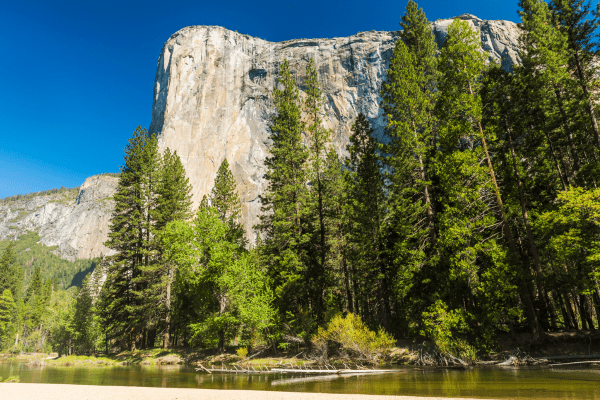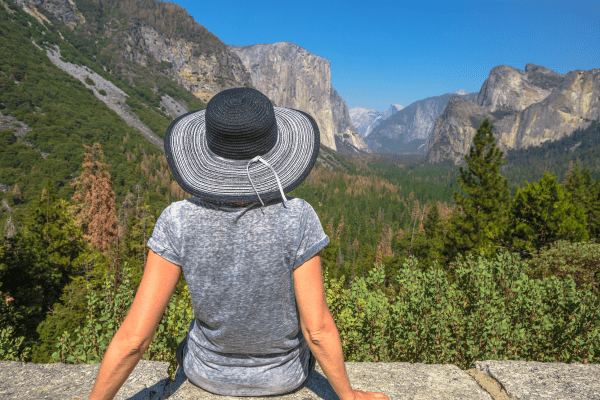

Yosemite National Park's landmark, El Capitan, is the largest granite monolith in the world at 3,000 feet. See the wonders of this majestic mountain with your own eyes!
Here are some helpful facts about El Capitan:
Location: Yosemite National Park, California
Height: 3,000 feet
Annual visitors: approx.4 million
Hot Spots: El Capitan Meadow, The Nose, El Capitan Bridge, Yosemite Falls, El Capitan Summit, Zodiac Wall.

The following sites are not to be missed when visiting El Capitan:
This large meadow at the base of El Capitan offers a beautiful view of the rock and is a popular spot for hikers and climbers exploring El Capitan.
The Nose is a famous climbing route on El Capitan. The route goes straight up the middle of the rock. It is considered one of the most challenging and famous climbing routes in the world.
The El Capitan Bridge is a modern steel structure that majestically spans the beautiful Merced River. The bridge offers a spectacular view of El Capitan, one of the most famous rocks in the park. The view from the El Capitan Bridge is simply indescribable. The breathtaking beauty of Yosemite National Park can be seen in all its glory from here.
Yosemite Falls, the highest waterfall in Yosemite National Park, consists of three parts: the upper, middle, and lower falls, with a height of 739 meters. Yosemite Falls provides a fantastic backdrop for unique photo opportunities. You can see the falls from several vantage points and even take a hike to get up close and personal.
The summit of El Capitan is approximately 2,307 meters high and offers a spectacular view of the park and surrounding mountains. The summit is the perfect place to enjoy a magnificent view of the surrounding landscape. If you are looking for a challenge, you can take a climbing tour to reach the summit.
Tuolumne Meadows is a beautiful place to enjoy nature and relax. Majestic mountains surround the vast meadows and provide an incredible backdrop. Here you can hike, picnic, and enjoy the breathtaking views.

Another highlight of the park is the Tuolumne River. It is a popular destination for kayakers and offers the perfect opportunity to enjoy the clear water and nature. You can also hike, fish, and camp along the river.
Tioga Pass runs through the Sierra Nevada and offers breathtaking views of the region. The pass road passes through some of the park's most impressive scenery and offers numerous overlooks to stop and take in the view.
Wawona is a small village in Yosemite National Park with a rich history. Here you can visit old buildings and landmarks and learn about the park's history. Visit the Pioneer Yosemite History Center to learn more and experience the unique sights.
El Capitan is a majestic granite monolith in California's Yosemite National Park. It was formed millions of years ago when tectonic forces pushed up the Sierra Nevada mountains.
The granite that makes up El Capitan was exposed as the surrounding sedimentary rocks were eroded and sculpted by glaciers during the Ice Age.
El Capitan has been and continues to be a source of inspiration for many. In the late 19th century, John Muir wrote about the area in his book The Yosemite. He described the beauty of El Capitan and the surrounding park and played an essential role in efforts to protect it. The first ascent of El Capitan was made in 1958 by Warren Harding and his team. This began a long tradition of climbers attempting to scale the monolith.
In the 1980s, Yosemite Valley has declared a World Heritage Site by UNESCO. This helped protect the area, including El Capitan, from development.
Another event that affected El Capitan was the 1990 Yosemite Fire, which caused significant damage to the region, including El Capitan. Fortunately, the natural beauty of El Capitan was not destroyed.
Today, El Capitan remains a beautiful and majestic sight. At over 3,000 feet, it is a breathtaking example of the power and beauty of nature. It reminds us of the importance of preserving our natural habitats and protecting them for future generations.
El Capitan is accessible from several entrances to Yosemite National Park, and driving is one of the most convenient ways to explore the park. It should be noted, however, that some roads may be closed due to snow in the winter, so it is important to check current conditions and bring snow chains if necessary.
The closest airport to Yosemite National Park is Fresno Yosemite International Airport, about 1.5 hours away. From here, you can rent a car or take a shuttle to the park. Tip for public transportation fans: The Yosemite Area Regional Transportation System (YARTS) provides bus service to several park entrances.
Regardless of how you choose to travel, it is recommended that you plan and book early, especially during peak season. Yosemite National Park is a popular destination, and accommodations and activities can fill up quickly.
It's also important to follow park rules and safety precautions. For example, bring bear-proof containers for your food and always carry plenty of water and appropriate gear.
El Capitan has climbing routes for all levels, from beginner to expert. It is important to bring the proper climbing equipment, such as a harness, helmet, and climbing ropes.
With an ESTA, you can stay 90 days visa-free in the USA. Apply online now!